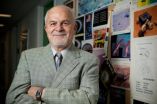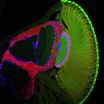(Press-News.org) NASA's Stardust spacecraft, equipped with the University of Chicago's Dust Flux Monitor Instrument (DFMI), is hurtling at more than 24,000 miles an hour toward a Valentine's Day encounter with comet Tempel 1.
Stardust will approach to within 124 miles of Tempel 1 at 10:56 p.m. CST Monday, Feb. 14. The spacecraft flew within 150 miles of comet Wild 2 in 2004, when it collected thousands of tiny dust particles streaming from the comet's nucleus for laboratory analysis.
The spacecraft dropped off the samples in a canister that parachuted onto the desert salt flats of Utah in January 2006 following a journey of nearly approximately 3.5 billion miles. But Stardust, still healthy and with fuel to spare, soon went back onto the interplanetary market, looking for a second mission.
The mission will be the first to allow Thanasas Economou, Senior Scientist at UChicago's Enrico Fermi Institute, and his fellow members of the Stardust-NExT (New Exploration of Tempel) science team to look for changes on a comet's surface that occurred following an orbit around the sun. They will compare Stardust's data from Tempel 1 with findings from a previous probe that also studied that comet.
"We are very excited that we can visit a second comet—comet Tempel 1—with the same spacecraft after we visited the Wild 2 comet in 2004," Economou said. "The Dust Flux Monitor Instrument is healthy and ready to take another look at this comet."
Stardust had only one sample-return canister, so this time the spacecraft will be unable to capture cometary dust for analysis back on Earth. Few at the time thought that the spacecraft would be able to visit another comet, "but even so, we are looking forward to seeing what kind of results we will get," Economou said.
Sizing up a new crater
They also are interested in obtaining photographs of the crater left on Tempe 1 by a probe launched from the Deep Impact spacecraft in July 2005. The 817-pound copper-aluminum probe generated so much dust that the spacecraft was unable to obtain images of the crater following impact. Such images would permit scientists to estimate the new crater's depth and diameter.
The impact enabled scientists to study the composition of Tempel 1, a Jupiter-class comet whose orbit has been modified by close passages to the planet. Stardust now has the opportunity to collect additional data on how Jupiter-family comets formed and evolved.
The DFMI was developed by Economou and the late John Simpson, the Arthur Holly Compton Distinguished Service Professor Emeritus in Physics, and the late Anthony Tuzzolino, Senior Scientist in UChicago's Fermi Institute.
The instrument detected as many as several hundred particles each second during Stardust's flyby of comet Wild 2 in January 2004. Most of those particles measured no more than a few microns in diameter, too small to see with the naked eye. Just a few measured more than 10 microns, about one-fifth the diameter of a human hair.
Tempel 1 has displayed less surface activity than did Wild 2, "but we are going there with a higher velocity, so probably the flux will be equal to or a little more than we had during the Wild 2 encounter," Economou said.
The Tempel 1 flyby likely will be the last assignment for Stardust, which is running low on fuel after logging almost 3.7 billion miles in space since its launch in 1999. Economou, meanwhile, will continue his collaborations on NASA's Mars Exploration Rover mission and the Cassini mission to Saturn. He also is working to establish a new astronomical observatory near his childhood home in Ziakas, Greece.
INFORMATION:
Related links:
Jet Propulsion Laboratory Featured Scientist Interview with Thanasis Economou
http://stardustnext.jpl.nasa.gov/science/economou_inter.html
Starlit memories lead scientist back to his roots (Jan. 11, 2010)
http://www.uchicago.edu/features/20100111_economou.shtml
Stardust-NexT web video:
http://www.jpl.nasa.gov/video/index.cfm
University researchers examine Stardust mission's comet samples (April 27, 2006)
http://chronicle.uchicago.edu/060427/stardust.shtml
University instrument collects data on Stardust (July 15, 2004)
http://chronicle.uchicago.edu/040715/stardust.shtml
Argonne scientists' stardust analysis brings nucleosynthesis full circle (Feb. 19, 2004)
http://chronicle.uchicago.edu/040219/stardust.shtml
NASA launches Chicago scientists' data-collection instrument on Stardust (March 18, 1999)
http://chronicle.uchicago.edu/990318/stardust.shtml
2-timing spacecraft has date with another comet
2011-02-14
ELSE PRESS RELEASES FROM THIS DATE:
CCRA Introduces "Better Than Best" Rate Program For Travel Agent Hotel Bookings
2011-02-14
CCRA Travel Solutions - a leading provider of business-related solutions for professional travel planners and industry suppliers - today announced the launch of a new program called, "Better Than Best." Through this new CCRA program, over 18,800 participating hotels will be offering travel agents and agencies discounts up to 30% off their Best Available Rates (BAR) for GDS bookings made through the CCRA rate codes.
"With CCRA's new Better Than Best rate program, travel professionals will now be able to access and book fully commissionable rates that are lower than what ...
Study finds that electronic fetal heart rate monitoring greatly reduces infant mortality
2011-02-14
SAN FRANCISCO (February 12, 2011) — In a study to be presented today at the Society for Maternal-Fetal Medicine's (SMFM) annual meeting, The Pregnancy Meeting ™, in San Francisco, researchers will present findings that prove that the use of fetal heart rate monitors lowers the rate of infant mortality.
There have been a handful of small studies conducted in the past that looked at the effectiveness of fetal heart rate monitors, but none of them were large enough to be conclusive.
"There was some criticism within the obstetric community that fetal heart rate monitoring ...
Eating berries may lower risk of Parkinson's
2011-02-14
ST. PAUL, Minn. –New research shows men and women who regularly eat berries may have a lower risk of developing Parkinson's disease, while men may also further lower their risk by regularly eating apples, oranges and other sources rich in dietary components called flavonoids. The study was released today and will be presented at the American Academy of Neurology's 63rd Annual Meeting in Honolulu April 9 to April 16, 2011.
Flavonoids are found in plants and fruits and are also known collectively as vitamin P and citrin. They can also be found in berry fruits, chocolate, ...
Scripps Research study sheds light on RNA 'on/off switches'
2011-02-14
LA JOLLA, CA – Embargoed by the journal Nature Structural and Molecular Biology until February 13, 2011, 1 PM Eastern time – Scientists from The Scripps Research Institute have shed new light on a molecular switch that turns genes on or off in response to a cell's energy needs.
The study—published February 13, 2011 in an Advance Online Publication of the journal Nature Structural and Molecular Biology—shows these recently discovered RNA "riboswitches" are capable of more complex functions than originally thought. In addition, because riboswitches so far have been found ...
Prayer/Life Up for eWorld Music Award
2011-02-14
Infusing soul and incredible depth into an intoxicating blend of contemporary folk and new age music—this is the rock solid foundation for one of the hottest up and coming groups in the Christian genre. The duo of Andrea Davis-Griffin and John Stallworth teamed up to form the inspiring and thought-provoking creation known as Prayer/Life while delivering a positive message driven by faith. Their initial success is reaching new heights, and the group is asking fans to help vote for them in the eWorld Music Awards via the Boomerang Media Station.
Drawing comparisons to ...
Fleeting fluctuations in superconductivity disappear close to transition temperature
2011-02-14
UPTON, NY — As part of an ongoing effort to uncover details of how high-temperature superconductors carry electrical current with no resistance, scientists at Johns Hopkins University and the U.S. Department of Energy's Brookhaven National Laboratory have measured fluctuations in superconductivity across a wide range of temperatures using terahertz spectroscopy. Their technique allows them to see fluctuations lasting mere billionths of a billionth of a second, and reveals that these fleeting fluctuations disappear 10-15 Kelvin (K) above the transition temperature (Tc) at ...
Study finds massive flux of gas, in addition to liquid oil, at BP well blowout in Gulf
2011-02-14
Athens, Ga. – A new University of Georgia study that is the first to examine comprehensively the magnitude of hydrocarbon gases released during the Deepwater Horizon Gulf of Mexico oil discharge has found that up to 500,000 tons of gaseous hydrocarbons were emitted into the deep ocean. The authors conclude that such a large gas discharge—which generated concentrations 75,000 times the norm—could result in small-scale zones of "extensive and persistent depletion of oxygen" as microbial processes degrade the gaseous hydrocarbons.
The study, led by UGA Professor of Marine ...
Aspira Continuing Education Offers The Courses Required for Already Licensed Mental Health Professionals Seeking the CA BBS Grandparenting Path to LPCC Licensure
2011-02-14
For those previously seeking MFT continuing education, there is a new path available in California. The California Board of Behavioral Sciences (CA BBS) has created a new licensing category, LPCC (licensed professional clinical counselor). This new license can be obtained not only from existing licensed professionals in California, but from those licensed in other states as well. For a short period of time, the CA BBS has made available a process to apply for their LPCC license, called the "grandparenting" path. This path will differ for those licensed outside of California ...
Partnership of genes affects the brain's development
2011-02-14
VIDEO:
This is a 3D-rotation through the optic lobe of a fly larva's brain. Blue are axons of the photoreceptor nerve cells, the two guidance proteins are shown in green (GoGo)...
Click here for more information.
The human brain consists of approximately one hundred billion nerve cells. Each of these cells needs to connect to specific other cells during the brain's development in order to form a fully functional organism. Yet how does a nerve cell know where it should ...
Green Vanity Provides On-Set Alternative to Environmentally Insensitive Production Units
2011-02-14
Whether it's Leonardo DiCaprio, Angelina Jolie or Natalie Portman, it seems that just about every Hollywood celebrity champions a noble environmental cause these days. But how often is this environmental concern brought directly to the film sets that such A-level stars work on? Green Vanity is a full-service mobile vanity unit that delivers environmental awareness directly to any Hollywood film set, project or event.
"The Hollywood film community has done a tremendous amount of work for the environment and raised awareness of many of the most urgent issues that concern ...

